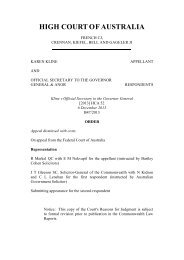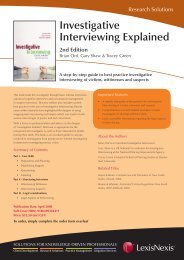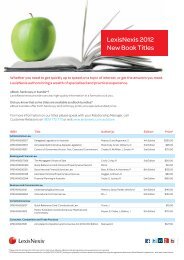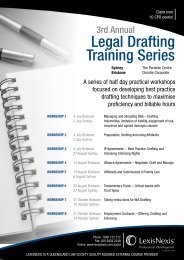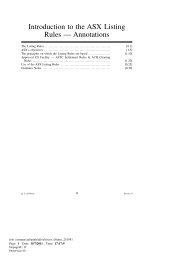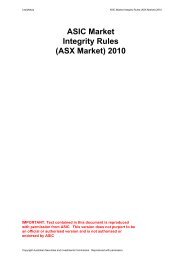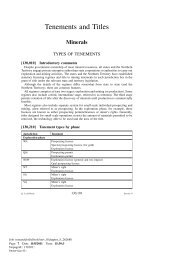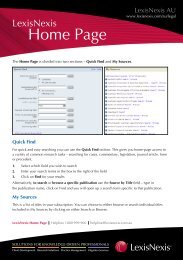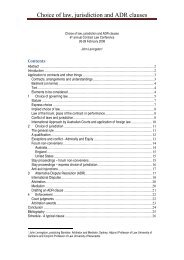Winners & Losers - LexisNexis
Winners & Losers - LexisNexis
Winners & Losers - LexisNexis
Create successful ePaper yourself
Turn your PDF publications into a flip-book with our unique Google optimized e-Paper software.
<strong>Winners</strong> & <strong>Losers</strong><br />
What is the future for corporate insolvency in Australia?<br />
Tim Somerville<br />
Partner, Somerville Legal<br />
February 2012<br />
The opinions expressed in this whitepaper are those of the author<br />
and not necessarily the opinions of <strong>LexisNexis</strong> Pacific.
Introduction<br />
In recent times, the collapse of such companies as HIH have emphasised<br />
the destructive impact of corporate insolvency, not only on companies as<br />
a whole but also on their employees, share holders, creditors and tax<br />
payers. Tim Somerville explores these impacts and the role of liquidators,<br />
as part of the government’s responses to the problems.<br />
.<br />
Background<br />
On 4 January 2012, the Australian Securities and Investments Commission (ASIC) published statistics showing how<br />
little creditors receive from companies in liquidation. This comes two years after Nationals Senator John Williams<br />
told the Senate of the “human and financial tragedy” caused by the collapse of the Australian financial services<br />
provider, Storm Financial in early 2009 1 . This led to the Senate appointing a committee to look into the insolvency<br />
industry, which reported in September 2010 2 .<br />
This paper considers the objectives of the Australian corporate insolvency system, whether it is meeting those<br />
objectives and what can be done to solve the problems. In particular, the recommendations of the Senate inquir y<br />
and their effect on corporate insolvency in Australia will be examined.<br />
Is the corporate liquidation system meeting its objectives?<br />
The website of the Australian Securities and Investments Commission (ASIC) states:<br />
The purpose of liquidation of an insolvent company is to have an independent and suitably qualified<br />
person (the liquidator) take control of the company so that its affairs can be wound up in an orderly<br />
and fair way for the benefit of creditors. 3<br />
Is the system working for the benefit of creditors?<br />
Companies often have secured creditors, such as banks and finance companies, who hold a mortgage or charge<br />
over company assets. They are not the creditors who need help. The victims of company liquidation are the<br />
unsecured creditors, referred to in this paper as “ordinary creditors”. They are generally the employees or suppliers<br />
of the failed company.<br />
1 Sen John Williams, Opinion Piece (2011) < http://www.johnwilliams.com.au/index.php?option=com_content&view=article&id=144:opinion -<br />
piece&catid=26:media&Itemid=176> at 17 August 2011.<br />
2 Senate Economics Reference Committee, The regulation, registration and remuneration of insolvency practitioners in Australia: the case for a<br />
new framework (2010) Parliament of Australia < http://www.aph.gov.au/Senate/committee/economics_ctte/liquidators_09/report/report.pdf ><br />
at 17 August 2011.<br />
3 ASIC, Information Sheet 45 (2008)<br />
at<br />
17 August 2011.<br />
<strong>Winners</strong> & <strong>Losers</strong>: What is the future for corporate insolvency in Australia ?<br />
www.lexisnexis.com.au/practicalguidance<br />
2
The following table shows how many of the companies under external administration made payments to the<br />
ordinary creditors. 4<br />
Estimated cents in the $ dividend to unsecured creditors<br />
0 0-11c 11–20c 21–50c 51–100c<br />
Australian Capital Territory 96 8 3 4 8<br />
New South Wales 3596 151 46 28 22<br />
Northern Territory 14 2 - 1 -<br />
Queensland 1369 49 22 16 12<br />
South Australia 281 18 5 2 2<br />
Tasmania 54 3 - 1 -<br />
Victoria 1593 75 16 18 11<br />
Western Australia 422 63 13 19 9<br />
International 2 - - - -<br />
Total 7427 369 105 89 64<br />
According to the table, unsecured creditors of over 92% of the companies will receive nothing. In fact, ordinary<br />
creditors of over 99.2% of the companies will receive less than 50 cents in the dollar.<br />
Clearly, this system is not operating in the interests of the ordinary creditors.<br />
The winners<br />
There are no detailed statistics available on how much liquidators earn. Some published reports about particular<br />
companies give some insight, many showing multimillion dollar payments to liquidators. There are also countless<br />
smaller liquidations, where all of the company’s money and assets (other than money for secured creditors) go to<br />
the liquidator.<br />
Where do the countless millions of dollars paid to the liquidators come from?<br />
4 ASIC, Australian insolvency statistics (2011) < http://asic.gov.au/asic/pdflib.nsf/LookupByFileName/Insolvency-stats-series-1-issued-August-<br />
2011.pdf/$file/Insolvency-stats-series-1-issued-August-2011.pdf> at 17 August 2011.<br />
<strong>Winners</strong> & <strong>Losers</strong>: What is the future for corporate insolvency in Australia ?<br />
www.lexisnexis.com.au/practicalguidance<br />
3
The losers<br />
1. Creditors<br />
Virtually all the money paid to liquidators comes from the companies’ money, money which would<br />
otherwise go to the creditors. In other words, it is the creditors who pay the fees taken by liquidators.<br />
However, they are not the only losers.<br />
2. Creditors of creditors<br />
Where a company goes into liquidation, with nothing paid to creditors, this can cause unpaid creditors also<br />
to become insolvent and end up in the hands of liquidators.<br />
3. The taxpayer<br />
The largest loser from Australian corporate insolvency is the Australian taxpayer.<br />
Payment of liquidators’ fees.<br />
The Australian Tax Office (ATO) is a large unsecured creditor of most companies going into<br />
liquidation. In effect, the Australian taxpayer is footing the bill for a large percentage of the fees<br />
taken by liquidators.<br />
Tax losses<br />
Creditors of failed companies claim a tax deduction for their bad debts. How much more tax would<br />
be collected if the money and assets of the companies taken by the liquidators went to ordinary<br />
creditors?<br />
Preferences<br />
Payments to creditors in the 6 months before the commencement of the winding up must be paid<br />
back to the liquidator, subject to certain exceptions. A large percentage of these payments<br />
collected by liquidators come from the ATO. There are no published detailed figures, but the<br />
amounts involved are many millions of dollars.<br />
The GEERS scheme<br />
The General Employee Entitlements and Redundancy Scheme (GEERS) is a government payment<br />
to employees for unpaid entitlements from failed companies. Since its inception, it has cost the<br />
Australian government the better part of one billion dollars. If money otherwise payable to<br />
employees were not taken by liquidators, there would be hu ge savings to the Australian taxpayer.<br />
Again, no detailed published figures are available to calculate this loss.<br />
Incentives not to pay tax<br />
Insolvency law strongly encourages company directors not to try to pay the tax owed by the<br />
company. Company directors are personally penalised for making payments of tax from a struggling<br />
company and for trying to trade their way through financial difficulty.<br />
<strong>Winners</strong> & <strong>Losers</strong>: What is the future for corporate insolvency in Australia ?<br />
www.lexisnexis.com.au/practicalguidance<br />
4
The mystique of the liquidator<br />
Under s 532 of the Corporations Act, only registered liquidators can liquidate insolvent companies. Also, once you<br />
appoint a liquidator, you cannot disengage them, without an expensive court case. 5<br />
This raises a number of questions. Why should these special rules apply to this exclusive club? Why can’t any<br />
chartered accountant liquidate an insolvent company? Why can’t a liquidator be removed from the case?<br />
The liquidators’ response is that the system is so complex that only they have the specialised knowledge to be<br />
trusted with the job.<br />
However, modern technology makes the application of the insolvency laws readily available to any accountant or<br />
lawyer. The laws on insolvency are far simpler than the tax laws which chartered accountants deal with every day.<br />
Liquidators’ fees<br />
Liquidators generally charge according to hourly rates set b y each individual liquidator. The following chart shows<br />
the rates charged by a typical firm. 6 However, some charge much more.<br />
Classification<br />
Hourly Rate<br />
(excl. GST)<br />
Description<br />
Partner 520.00 Registered liquidator or bankruptcy trustee. Brings his or her specialist skills to the<br />
administration or insolvency task.<br />
Director 1 375.00 Typically CA or CPA qualified with in excess of 10 years experience on insolvency<br />
Director 2 340.00 matters with a number of years at manager level. Answerable to the appointee but<br />
otherwise responsible for all aspects on an administration. Capable of controlling all<br />
aspects of an administration. May be appropriately qualified to take appointments in<br />
his/her own right.<br />
Manager 1 260.00 Typically CA or CPA qualified with 6 to 8 years experience working on insolvency<br />
Manager 2 220.00 matters. Will have experience conducting administrations and directing a number of<br />
staff.<br />
Senior Analyst 1 200.00 Typically completed or near completion of CA or CPA qualifications with 4 to 6 years<br />
Senior Analyst 2 185.00 insolvency experience. Assists in planning and control of smaller matters as well as<br />
Senior Analyst 3 160.00 performing some more difficult tasks on larger matters.<br />
Analyst 1 155.00 Typically studying towards CA or CPA qualification with 2 to 4 years insolvency<br />
Analyst 2 145.00<br />
Analyst 3 135.00<br />
Graduate 130.00<br />
experience. Works under supervision of more senior staff in performing day -to-day<br />
fieldwork.<br />
Support A 130.00 Generally a person currently undertaking a university degree. Works under<br />
Support B 115.00 supervision in providing assistance on tasks involved in insolvency matters.<br />
Vacationer 125.00<br />
5 ss 473, 503, 536, Corporations Act 2001 (Cth)<br />
6 Richard J Hughes and John L Greig, Guidance to Creditors on Remuneration (9 March 2009) Deloitte Touch Tohmatsu (2009)<br />
.<br />
<strong>Winners</strong> & <strong>Losers</strong>: What is the future for corporate insolvency in Australia ?<br />
www.lexisnexis.com.au/practicalguidance<br />
5
However, the main issue is with the number of hours recorded. In the HIH meltdown, one firm of liquidators was<br />
appointed to liquidate all of the Australian companies. Fees up until August 2005 are shown in the following table. 7<br />
Company<br />
HIH Casualty & General<br />
Insurance Limited<br />
Liquidators’ Liquidators’ fees<br />
fees paid<br />
unpaid<br />
$22,043,549 $885,019<br />
Total Liquidators’<br />
fees<br />
$22,928,568<br />
FAI General Insurance<br />
$13,869,656 $630,649<br />
Co Limited<br />
$14,500,305<br />
CIC Insurance Limited $4,450,097 $134,565 $4,584,662<br />
World Marine &<br />
General Insurances Pty<br />
Limited<br />
$204,075 $135,156<br />
$339,231<br />
FAI Traders Insurance<br />
Co Limited<br />
$10,340 $24,187<br />
$34,527<br />
FAI Reinsurances Pty<br />
Limited<br />
Nil $24,274<br />
$24,274<br />
FAI Insurances Limited $1,195,098 $54,925 $1,250,023<br />
HIH Underwriting &<br />
Insurance (Australia)<br />
Pty Limited<br />
$13,517 $40,193<br />
$53,710<br />
Total $41,786,332 $1,928,968 $43,715,300<br />
The total of over $43m assuming an average rate of $200 per hour would equal a person working for 40 hours per<br />
week for 114 years.<br />
The need for liquidators<br />
There are two sides to every story. While creditors feel aggrieved that their money is going to pay liquidators’ fees,<br />
liquidators are a vital part of the insolvency regime under the Corporations Act.<br />
For simplicity, insolvency practitioners are referred to in this paper as “liquidators” whether acting as<br />
administrators, receivers or liquidators. In all of these roles, they are an essential part in the way the law deals with<br />
insolvent companies.<br />
Deeds of company arr angements<br />
A deed of company arrangement (DOCA) is an agreement binding on an insolvent company and its creditors, under<br />
which payments are proposed to be made to the cr editors, usually by the company continuing to trade. The DOCA is<br />
proposed by the liquidator and adopted by a meeting of creditors.<br />
DOCA’s can give real benefits to creditors, compared to liquidation. As soon as the DOCA is signed, the company is<br />
generally handed back to the directors. Provided they generate the money to pay the liquidator’s fees and the part<br />
payments to creditors required by the DOCA, they can then continue to run the company in the future.<br />
7 McGrath Nicol and Partners, Form 524 Presentation of Accounts and Statement by Liquidator (For the period ended 26 August 2005)<br />
.<br />
<strong>Winners</strong> & <strong>Losers</strong>: What is the future for corporate insolvency in Australia ?<br />
www.lexisnexis.com.au/practicalguidance<br />
6
There are many companies still in business today, after going through the DOCA process. Those companies would<br />
be out of business, if they had simply gone into liquidation. The creditors of these companies often receive more<br />
than they would have received under a liquidation.<br />
The Corporations Act requires a liquidator to act as administrator of the funds collected under the deed. 8<br />
Preventing insolvent trading<br />
It is clearly in the interests of the community to stop companies trading while insolvent. Otherwise, they continue to<br />
run up debts to creditors, who may never be paid.<br />
It is illegal for directors to allow a company to continue to trade while insolvent. 9 However, many directors ignore this<br />
as they refuse to face the reality that their business has failed.<br />
In such cases, creditors can apply to the cour ts to have the company placed into liquidation. The ATO, more than<br />
any other creditor uses this process to put insolvent companies into liquidation. This stops them incurring further<br />
debt and also stops the directors from using the company’s tax losses to reduce future tax.<br />
Of course, this process requires a registered liquidator.<br />
Receivership<br />
Banks and other lenders often require a registered charge before they will lend money to a company. A charge over a<br />
company is like a mortgage over a house. It gives the lender security over the company’s assets.<br />
What makes a charge different from a mortgage is that it usually applies to all of the company’s assets. However,<br />
these assets change from day to day as the company buys stock, sells goods, obtains payment of invoices, etc. Such<br />
a charge is described as a “floating charge”, meaning that it floats above the company’s assets and only attaches to<br />
them if the company defaults.<br />
When there is a default, the creditor needs to appoint a receiver to go into the compan y and take possession of<br />
whatever assets are then on hand, for the benefit of that creditor. By law, a receiver must be a registered liquidator. 10<br />
If this system did not exist, businesses would be unable to raise loans on the security of assets such as stoc k.<br />
Accordingly, the receivership system is a vital part of corporate commerce.<br />
The policing role<br />
Companies can be used to commit fraud. For example, in some industries it is common to employ low -paid staff<br />
through companies, paying no superannuation, PAYG or other taxes. When these liabilities build up, the companies<br />
are liquidated and the staff are moved to another company to repeat the process.<br />
Part of the role of liquidators is to report these and other breaches of the Corporations Act to ASIC. This is a legal<br />
requirement under the Corporations Act for liquidators, 11 for receivers 12 and for administrators 13 .<br />
8 s 444A(2), Corporations Act 2001 (Cth)<br />
9 s 588G, Corporations Act 2001 (Cth)<br />
10 s 418, Corporations Act 2001 (Cth)<br />
<strong>Winners</strong> & <strong>Losers</strong>: What is the future for corporate insolvency in Australia ?<br />
www.lexisnexis.com.au/practicalguidance<br />
7
Only a small percentage of these offences are ever prosecuted. However, without the reporting role of liquidators,<br />
the number of prosecutions would probably be even smaller.<br />
Why liquidators need to be paid from creditors’ funds<br />
The need for liquidators to be paid<br />
The facts are simple. Our insolvency regime needs liquidators. Liquidators need to be paid. There is no system<br />
for paying liquidators other than from the funds of the companies, or from money able to be clawed -back<br />
from creditors, directors or other third parties.<br />
Cross subsidising small liquidations<br />
Most insolvent companies are small companies with little or no assets. The following table 14 , published by<br />
ASIC, shows that over 60% of companies placed into liquidation have less than 5 full time employees. Only<br />
5.4% are recorded as having more than 20 full time employees.<br />
Table 7: Initial external administrators’ reports—Size of company as measured by number<br />
of full-time employees (“FTE”) (1 July 2009–30 June 2010)<br />
Less than 5 FTE 4,766 60.3%<br />
Between 5 and 19 FTE 1,296 16.4%<br />
Between 20 and 199 FTE 392 5.0%<br />
200 or more FTE 28 0.4%<br />
Not known 1,421 18.0%<br />
Total 7,903 100.0%<br />
In many liquidations of these smaller companies, the only way the liquidator can be paid is by clawing back payments<br />
made to creditors in the period leading up to the liquidation. If they could not claim these payments back from the<br />
creditors and use them to pay their fees, they would often be unpaid.<br />
Being appointed as a liquidator of a company involves the liquidator spending at least several hours of work, even for<br />
a company with no assets. Under the present system, many liquidators will consent to being app ointed as liquidator<br />
of any company, sight unseen. They realise that in many cases, they will work for a number of hours and receive<br />
nothing. Their incentive is the hope of finding a company where they will be paid, often by clawing back payments<br />
previously made to creditors.<br />
11 s 533, Corporations Act 2001 (Cth)<br />
12 s 422, Corporations Act 2001 (Cth)<br />
13 s 438D, Corporations Act 2001 (Cth)<br />
14 ASIC, Insolvency statistics: External administrators’ reports 1 July 2007–30 June 2010 (2010) at 17 August<br />
2011.<br />
<strong>Winners</strong> & <strong>Losers</strong>: What is the future for corporate insolvency in Australia ?<br />
www.lexisnexis.com.au/practicalguidance<br />
8
Why liquidators need to be paid highly<br />
When one looks at the amount charged by liquidators for individual liquidations, their fees seem very high. However,<br />
one should also consider the number of companies they liquidate, where they are paid nothing.<br />
Under the present system, the creditors of larger companies, in effect, subsidise the liquidation of companies with<br />
no assets where the liquidators are not paid.<br />
Comparison with bankr uptcy<br />
The liquidation system may be contrasted with bankruptcy, where a trustee is appointed to handle the bankrupt<br />
estate of an individual. Like liquidations, many bankrupt estates yield no money to pay the bankruptcy trustee.<br />
However, the bankruptcy system has a different solution.<br />
The Insolvency and Trustee Service Australia (ITSA) is a government body which supplies a bankruptcy trustee to<br />
any bankrupt estate. There are also private trustees for bankrupt estates. However, ITSA handles the majority of<br />
bankruptcies, where there is no money to pay fees.<br />
ITSA obtains a substantial part of its funds from a small percentage levy on the assets of bankrupt estates.<br />
Alternatives to the present remuneration system<br />
Since 2005, ASIC has administered a fund to pay liquidators for “assetless administrations”. However, the budget is<br />
very limited and the liquidator has to carry out substantial work before being eligible for any such payment.<br />
In July 2011, the Insolvency Practitioners Association of Australia, which represents around 85% of liquidators, made<br />
a submission to Treasury. 15 It suggested that funds to pay for assetless liquidations should be obtained from placing<br />
a levy on all new companies, as they are registered. This money would be used to pay liquidators of companies with<br />
no assets. They also put forward, but dismissed, the idea that ASIC should simply deregister those small insolvent<br />
companies, without any liquidation at all.<br />
In Hong Kong, there is a system for practitioners to bid for the work, quoting a fixed fee for the administration of<br />
insolvent companies.<br />
The present system for paying liquidators for administering assetless companies can at times be haphazard and<br />
unfair. It involves the liquidator agreeing to be appointed to any company, hoping that there will be some money that<br />
can be recovered, probably from payments to creditors. If so, those creditors, in effect, pay the liquidator’s fees. If<br />
not, the liquidator is unpaid.<br />
15 IPA, IPA Submissions (2011) at 17 August 2011.<br />
<strong>Winners</strong> & <strong>Losers</strong>: What is the future for corporate insolvency in Australia ?<br />
www.lexisnexis.com.au/practicalguidance<br />
9
Suggestions for reforms<br />
The following are some suggestions for reforms to the insolvency regime:<br />
1. Employee entitlements<br />
The law providing that 100% of liquidators’ fees be paid before any payment of employees’ entitlements 16<br />
should be changed. Because of the GEERS scheme, most of these employee entitlements are paid by the<br />
Australian government. The question arises, why should liquidat ors’ fees come before the rights of<br />
employees, at the expense of the taxpayer?<br />
2. Preferences<br />
A creditor who was paid by a company before it went into liquidation should not have to give that payment<br />
back to the liquidator, unless at least the majority of t hat money will go to the creditors, rather than being<br />
taken for liquidators’ fees.<br />
3. Insolvent trading<br />
If the directors allow a company to run up a debt when the company cannot pay it, they are personally liable<br />
for that debt. This is fair. However, by law 17 the liquidator has control over collecting that money from the<br />
directors. In practice, almost all of the money received goes to paying the liquidator’s fees, unless the<br />
liquidator consents to or the court permits, recovery by the creditor. Those creditor s should have the right<br />
to claim directly from the directors, without the money going to the liquidator.<br />
4. Incentives not to pay tax<br />
The many incentives for a company not to pay tax should be removed. The most blatant is the law 18 that<br />
directors may be personally liable for PAYG paid before the company was liquidated. It means that the<br />
directors of a struggling company, which pays that tax, will probably end up paying the tax personally, after<br />
the liquidator claims it back from the ATO as a preference. This s hould be repealed immediately. It is<br />
unreasonable to punish directors because their company paid tax.<br />
5. Liquidators’ monopoly<br />
The law should be changed to allow insolvent companies to be liquidated by chartered accountants or<br />
lawyers, who can be appointed and disengaged by the directors. This will expose liquidation fees to ordinary<br />
market forces.<br />
6. Assetless administration<br />
The existing assetless administration fund should be expanded to pay a reasonable fee to liquidators who<br />
are prepared to administer companies with no assets.<br />
16 s 556, Corporations Act 2001 (Cth)<br />
17 s 588M, Corporations Act (Cth)<br />
18 s 588FGA, Corporations Act (Cth)<br />
<strong>Winners</strong> & <strong>Losers</strong>: What is the future for corporate insolvency in Australia ?<br />
www.lexisnexis.com.au/practicalguidance<br />
10
Conclusion<br />
It is the view of this author that the Senate enquiry was sidetracked after receiving multiple submissions from<br />
liquidators and their lobby group. The Senate committee concentrated almost entirely on a small number of<br />
liquidators who broke the law.<br />
However, that is not the only problem. The main issue is the vast bulk of liquidators who legally pay themselves<br />
millions of dollars out of the companies’ money — money that would otherwise go to the employees and creditors,<br />
including the Australian taxpayer.<br />
The Senate committee’s first recommendation was that the Australian Insolvency Practitioners Authority (AIPA) be<br />
established as part of the Insolvency and Trustee Service Australia (ITSA), to take over from ASIC. It then<br />
recommended a further enquiry. These recommendations appear to have been ignored. However, we do not need<br />
another acronym or another enquiry. We need serious changes to the law to enable the funds of insolvent<br />
companies to go to the appropriate parties.<br />
About the author<br />
Tim Somerville is an<br />
accredited specialist in<br />
business law and provides<br />
business and taxation<br />
advice to small and<br />
medium sized businesses.<br />
He is the founding partner<br />
of Somerville Legal,<br />
established in 1983, and<br />
was also the president of<br />
the North Metropolitan<br />
Law Society from 2005 to<br />
2009, and has served on the Law Society Committee<br />
for specialist accreditation in business law.<br />
Tim Somerville is also the author of the Business Law<br />
module of <strong>LexisNexis</strong> Practical Guidance<br />
Since its establishment in 1983, Somerville Legal has<br />
rapidly grown to become North Sydney’s largest law<br />
firm, with accredited specialists in Business Law and<br />
Family Law, accredited Estate Planning practitioners,<br />
litigation specialists and notaries. For more<br />
information, visit www.somervillelegal.com.au.<br />
About <strong>LexisNexis</strong> Practical Guidance<br />
Designed to match the way you work, <strong>LexisNexis</strong><br />
Practical Guidance is like having your own specialist<br />
legal practitioner on your desktop.<br />
Our expert team of legal practitioners and the<br />
<strong>LexisNexis</strong> team of legal editors have put together a<br />
range of essential resources to guide you through a<br />
range of specific practice areas, including business<br />
law, family law, employment law, property law, and a<br />
general counsel module.<br />
<strong>LexisNexis</strong> Practical Guidance provides you with<br />
access to guidance notes, primary law, precedents,<br />
forms, checklists and excerpts from authoritative<br />
<strong>LexisNexis</strong> commentary, so you can cut costs, save<br />
time and focus<br />
on profitable client work and developing new<br />
business.<br />
For more information about how <strong>LexisNexis</strong> Practical<br />
Guidance can help your practice, visit<br />
www.lexisnexis.com.au/practicalguidance.<br />
The opinions expressed in this whitepaper ar e those of the author and not necessarily the opinions of <strong>LexisNexis</strong> Pacific.<br />
Media Contacts<br />
Rebecca Whalen<br />
PR, SEO & Social Media Manager<br />
<strong>LexisNexis</strong> Pacific<br />
(02) 9422 2681<br />
rebecca.whalen@lexisnexis.com.au<br />
Jennifer Armstrong<br />
Chief Marketing Officer<br />
<strong>LexisNexis</strong> Pacific<br />
(02) 9422 2639<br />
jen.armstrong@lexisnexis.com.au<br />
<strong>Winners</strong> & <strong>Losers</strong>: What is the future for corporate insolvency in Australia ?<br />
www.lexisnexis.com.au/practicalguidance<br />
11



